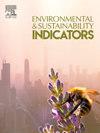交通-环境-技术-经济时空耦合关系及驱动因素——以黄河流域后u型弯道都市圈为例
IF 5.4
Q1 ENVIRONMENTAL SCIENCES
引用次数: 0
摘要
黄河流域后u型弯道都市圈作为枢纽都市圈,对国家战略推进具有重要意义。交通运输的快速发展有力地支撑了中国经济的高质量发展。同时,交通运输的演变和经济的扩张对城市环境的可持续发展也有明显的影响。本文运用耦合协调度模型、灰色关联度法和阈值回归模型分析了交通、环境、技术和经济系统(TETE)耦合协调度(CCD)的时空动态特征,并剖析了影响交通、环境、技术和经济系统耦合协调度的驱动因素。研究结果表明,在BUBMA内部,TETE系统的CCD逐渐上升,其特征是区域差异逐渐缩小。空间自相关分析表明,整个城市之间存在正相关关系,大多数城市表现出与邻近城市对齐的集群效应。值得注意的是,CCD高或低的城市在地理上是相近的。此外,这需要增加对交通基础设施建设的投资,坚定地致力于低碳绿色治理,并迅速制定和执行环境法规。加强省级政府的领导作用,凝聚集体力量,是加快协同发展的关键。本文章由计算机程序翻译,如有差异,请以英文原文为准。
Spatial-temporal coupling relationship and driving factors between transportation-environment-technology-economy:A case study of the Backward U-shaped Bend Metropolitan Area in the Yellow River Basin
The Backward U-shaped Bend Metropolitan Area (BUBMA) within the Yellow River basin holds significance as a pivotal metropolitan region, crucial to the national strategic advancement. Rapid advancements in transportation have substantially bolstered the high-quality progression of its economy. Concurrently, the evolution of transportation and economic expansion exert a discernible influence on the environmentally sustainable development of BUBMA. In this research, we scrutinized the spatio-temporal dynamics of the coupling coordination degree (CCD) among the Transportation, Environment, Technology, and Economic System (TETE system) and dissected the underlying driving factors by utilizing the coupling coordination degree model, the grey relational degree method and threshold regression model. The findings indicate a progressive ascent in the CCD of the TETE system within BUBMA, marked by diminishing regional disparities. Spatial autocorrelation analysis reveals a positive correlation encompassing the entirety of BUBMA, with most cities displaying cluster effects that align with neighboring cities. Notably, cities with high or low CCD are geographically proximate. Additionally, this necessitates heightened investments in transportation infrastructure construction, a steadfast commitment to low-carbon green governance, and expeditious formulation and enforcement of environmental regulations. Reinforcing the leadership role of provincial governments and fostering collective efforts is crucial in expediting the coordinated development of BUBMA.
求助全文
通过发布文献求助,成功后即可免费获取论文全文。
去求助
来源期刊

Environmental and Sustainability Indicators
Environmental Science-Environmental Science (miscellaneous)
CiteScore
7.80
自引率
2.30%
发文量
49
审稿时长
57 days
 求助内容:
求助内容: 应助结果提醒方式:
应助结果提醒方式:


